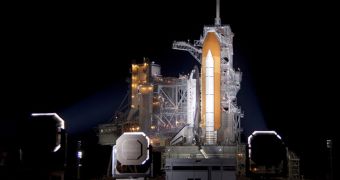Engineering crews at the Kennedy Space Center (KSC), in Cape Canaveral, Florida, have discovered yet another leak aboard the space shuttle Discovery, as the spacecraft was being fueled for a launch attempt today.
This is the third fuel leak discovered on the orbiter in less than two weeks, and NASA should start asking itself some pretty serious questions about these failures.
In addition to the fuel problems, an electronic glitch in one of the shuttle's engine controllers forced another scrubs a few days ago. It would indeed appear that Discovery's state is deteriorating.
This is the oldest orbiter in the American space fleet, and maybe this is why it is experiencing this many difficulties. Four issues in 14 days is not a good sign.
The new glitch occurred in a fuel supply line that connects the shuttle itself to its large, external fuel tank. Engineers discovered that highly-flammable hydrogen fuel was leaking out of the pipes.
Similar problems were discovered during two previous shuttle missions, that eventually flew to the International Space Station (ISS) safely back in 2009.
The shuttle was supposed to launch on November 1, but the program was delayed due to subsequent glitches. The last attempt was planned for today, November 5, at 7:30 am EDT (1130 GMT).
With the new leak, Discovery's take-off on the STS-133 flight has been delayed to Monday, November 8, which is the last day of the current launch window. This means that mission controllers will then have to wait until at lest December 1 to fly Discovery.
The malfunction was found about half an hour before launch, in the Ground Umbilical Carrier Plate, which connects the shuttle to the massive fuel tank. It was discovered as ground crews were filling up the tank with 520,000 gallons of cryogenic fuel.
NASA has yet to express an official stance on the number of malfunctions Discovery exhibited until now. Engineers really need to do a good job now, so as to prevent any type of malfunction from occurring in space.
The shuttle also need to be able to withstand the harsh conditions of an atmospheric ascent, and then spending 15 days in space. If its fuel lines are not secure, then the shuttle will be dead in the water, as they say.
During its 11-day stay on the ISS, the shuttle will deliver a logistics cargo module to the station, as well as the humanoid robot Robonaut 2, which was developed by NASA and General Motors.
The crew aboard the Discovery will carry out two maintenance spacewalks as well, to ensure that everything is properly affixed to the exterior of the station.
After returning home, the spacecraft will most likely go to the Smithsonian museum in Washington DC, for permanent display, NASA says.
Two other shuttle missions will take place before the program ends. Endeavor will fly to the ISS carrying the Alpha Magnetic Spectrometer in February 2011, and Atlantis will make its last flight in June 2011, Space reports.

 14 DAY TRIAL //
14 DAY TRIAL //